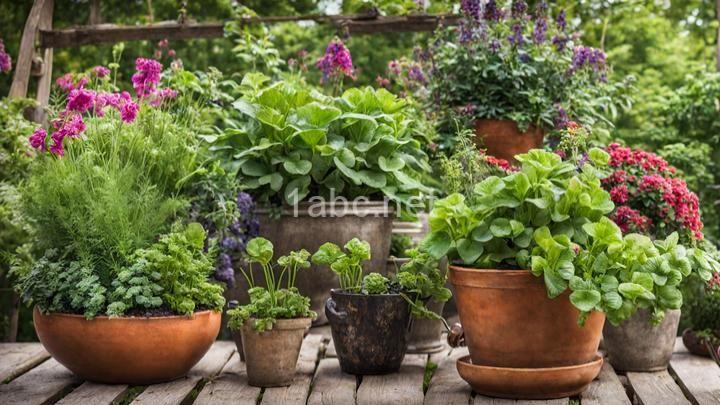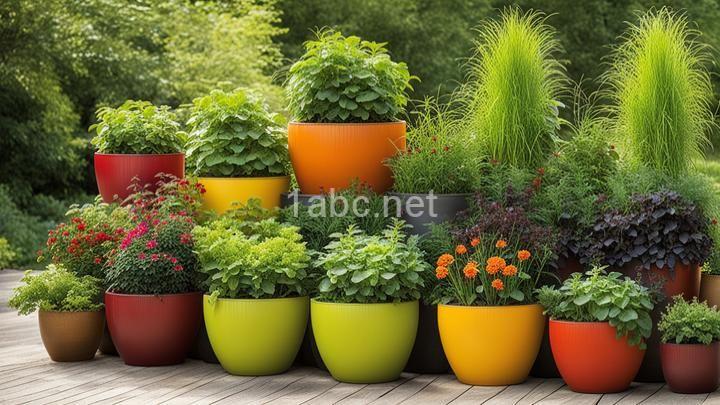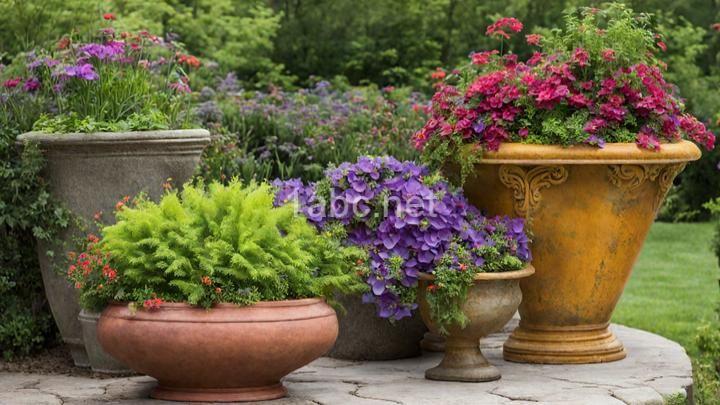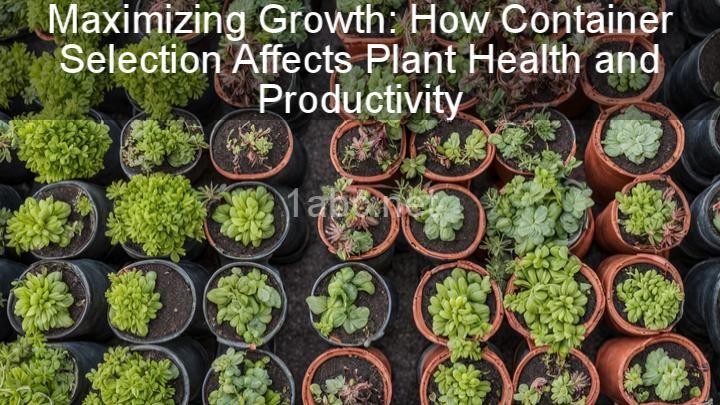Container Gardening for Beginners: Seasonal Care Made Easy

Introduction
Welcome to the world of container gardening! Whether you have limited space, a desire for a mobile garden, or simply want to add some greenery to your living space, container gardening is a fantastic option. In this guide, we will walk you through the essentials of seasonal care for your container garden, making it a breeze for beginners.
Container gardening offers a multitude of benefits and appeals to individuals of all gardening expertise levels. Not only does it allow you to create a beautiful and versatile garden, but it also provides the flexibility to move your plants around to optimize sunlight exposure or aesthetic appeal. Additionally, container gardening is ideal for those with limited mobility or accessibility concerns. With this guide, we aim to empower beginners to dive into the world of container gardening with confidence, knowing that seasonal care is made easy.
Section 1: Getting Started
To start your container gardening journey on the right foot, it is essential to understand the fundamentals. The first step is choosing the right containers. Opt for pots that are at least 10-12 inches deep with drainage holes in the bottom. This will ensure proper drainage, preventing root rot and other water-related issues. Additionally, consider the material of the containers. While terracotta pots are popular, they tend to dry out quickly, requiring more frequent watering. Alternatively, plastic pots retain moisture better. Ultimately, select containers that suit your aesthetic preferences and the needs of your plants.
Equally important is selecting the right soil for your container garden. Avoid using soil from your garden, as it may contain pests, diseases, or weed seeds. Instead, opt for a high-quality potting mix that is lightweight, well-draining, and contains organic matter to retain moisture. This will provide your plants with the necessary nutrients and ensure their healthy growth.
When choosing plants for your container garden, consider their sunlight requirements and your local climate. Some plants thrive in full sun, while others prefer partial shade. Observe the sunlight patterns in your outdoor space and select plants accordingly. Additionally, consider your climate zone and choose plants that are suited for your specific region. This will increase the chances of success for your container garden.
To ensure the health and vitality of your container plants, proper drainage is crucial. Without adequate drainage, excess water can accumulate in the containers, leading to root rot or other water-related issues. Place a layer of rocks or broken pottery shards at the bottom of the container to create a drainage layer. This will allow water to flow freely through the soil and out of the drainage holes, preventing waterlogged roots. Additionally, water your container plants thoroughly until water flows out of the drainage holes, then discard any excess water.
Section 2: Spring Care
As winter fades and spring arrives, it's time to prepare your container garden for a burst of new life. Begin by cleaning and refreshing your containers. Remove any debris, dead leaves, or old potting mix from the previous season. Rinse the containers with a diluted bleach solution to eliminate any potential pathogens. This will ensure a clean and healthy environment for your plants.
With the arrival of spring, a wide variety of flowers, herbs, and vegetables become available for container gardening. Choose plants that are well-suited to springtime conditions and your personal preferences. Some popular options include pansies, daffodils, tulips, chives, and lettuce. These plants will thrive in cooler temperatures and provide a vibrant and fragrant display.
To promote healthy growth and vibrant blooms, provide your plants with adequate nutrition through fertilization. Apply a slow-release fertilizer or organic compost to the soil surface and gently work it into the top layer. This will provide a steady release of nutrients to your plants over time. Additionally, consider using a liquid fertilizer diluted in water for regular feeding during the growing season.
While spring brings new growth and beauty, it can also bring unwelcome pests and diseases. Stay vigilant and monitor your plants regularly for signs of infestation or disease. Common pests in the springtime include aphids, slugs, and snails. If you notice any signs of infestation, take immediate action to prevent further damage. There are various organic and chemical methods available to control pests, so choose the method that aligns with your gardening principles and preferences.
Section 3: Summer Care
As the temperatures rise and summer sets in, it's essential to adjust your watering routines to accommodate the hotter weather. Container plants tend to dry out more quickly in the summer, requiring more frequent watering. Check the moisture level of the soil regularly by inserting your finger into the soil up to the first knuckle. If it feels dry, it's time to water. However, be cautious not to overwater, as it can lead to root rot. Aim to keep the soil consistently moist, but not waterlogged.
To prevent heat stress in your container plants, consider strategies such as mulching and providing shade. Apply a layer of organic mulch, such as compost or wood chips, to the surface of the soil. This will help retain moisture, regulate soil temperature, and suppress weed growth. Additionally, consider placing your containers in areas with partial shade during the hottest part of the day. This will protect your plants from intense sunlight and potential sunburn.
Deadheading is an important practice during the summer months to promote continuous blooms and maintain the overall appearance of your container garden. Remove faded flowers by pinching or cutting them off at the base. This will redirect the plant's energy towards new growth and encourage the production of more flowers. Regular deadheading will ensure a vibrant and colorful display throughout the summer season.
Section 4: Fall Care
As summer comes to an end and autumn approaches, it's time to transition your container garden for the cooler temperatures ahead. Begin by removing any summer annuals that have finished blooming or are showing signs of decline. This will create space for fall-friendly plants such as mums, ornamental cabbage, or kale. These plants thrive in cooler temperatures and provide stunning foliage color.
With the arrival of fall, it's crucial to prepare your container garden for potential frost. Move your containers to a sheltered location, such as a garage or porch, if possible. This will provide some protection from freezing temperatures and extend the growing season for your plants. Alternatively, consider covering your containers with frost blankets or burlap to provide insulation and protect your plants from frost damage.
During the autumn season, it's important to maintain the health of your container plants. Continue watering as needed, taking into account the cooler temperatures and potentially reduced water requirements. Monitor your plants for signs of disease or pests, as some issues may persist into the fall months. Promptly address any problems to prevent them from spreading or causing significant damage.
Section 5: Winter Care
As winter arrives and the temperatures drop, it's time to prepare your containers for the harsh conditions ahead. Remove any dead plant material or debris from your containers to prevent the growth of molds or pests. Consider applying a layer of mulch to the soil surface to insulate the roots and protect them from freezing temperatures.
For perennial container plants that are not cold hardy in your climate, overwintering strategies are essential. One option is to bring them indoors and place them in a cool, well-lit area such as a basement or a room with south-facing windows. Another option is to insulate the containers by wrapping them with insulating materials such as bubble wrap or burlap. This will provide additional protection from freezing temperatures.
Sensitive plants that are not cold hardy can also be protected from freezing temperatures or heavy snowfall by burying the containers in the ground. Dig a hole deep enough to accommodate the entire container and bury it, leaving the rim exposed. This will insulate the roots and protect the plant from extreme temperature fluctuations.
Conclusion
In conclusion, container gardening is a versatile and accessible way to enjoy the beauty of plants throughout the seasons. With proper seasonal care, your container garden can thrive year-round. This comprehensive guideline has provided you with the necessary knowledge and tips to ensure the success of your container garden. Remember to have fun experimenting with different plant combinations and embrace container gardening as a rewarding hobby. Happy gardening!
FREQUENTLY ASKED QUESTIONS
What is container gardening?
Container gardening is a method of growing plants in containers rather than directly in the ground. It is a popular option for people who have limited space, such as those living in apartments or those with small yards. In container gardening, plants are grown in pots, buckets, or other suitable containers filled with soil or growing media. This method allows for greater flexibility in terms of plant selection, location, and mobility. It is commonly used to grow flowers, vegetables, herbs, and even small trees or shrubs.
Why should I choose container gardening?
Container gardening offers several advantages that make it an attractive choice for many people:
- Space-efficient: Container gardening is perfect for those who have limited outdoor space. Whether you have a small balcony, patio, or even just a windowsill, you can still enjoy gardening by using containers.
- Flexibility: Containers give you the flexibility to move your plants around as needed. You can easily change the layout of your garden, relocate sun-sensitive plants, or protect delicate plants during extreme weather conditions.
- Weed and pest control: Compared to traditional gardening, container gardening is less prone to weed growth and pest infestations. The controlled environment of containers reduces the risk of invasive plants or pests taking over your garden.
- Accessibility: Container gardening is ideal for people with physical limitations or disabilities. By elevating the containers, you can avoid the need to bend or kneel to tend to your plants, making it easier to enjoy gardening regardless of mobility.
- Aesthetics: Containers can be chosen to match your personal style and complement your outdoor decor. You can create visually appealing arrangements by combining plants with different colors, textures, and sizes.
- Season extension: Containers offer the advantage of portability, which means you can bring them indoors during colder months to extend the growing season. This allows you to continue gardening and enjoy fresh produce even during winter.
Overall, container gardening offers convenience, versatility, and the opportunity to cultivate a beautiful garden in any space.
What are the benefits of container gardening for beginners?
Container gardening has several benefits for beginners:
- Space flexibility: Containers allow you to garden in small spaces such as balconies, patios, or even windowsills. It's perfect for those who don't have access to a traditional garden plot.
- Easy maintenance: Containers require less physical effort compared to traditional gardens. They are easier to weed, water, and tend to. This can be an advantage for beginners or individuals with limited mobility.
- Better control: With container gardening, you have full control over the soil type, quality, and drainage. This allows for better management of nutrients and water, resulting in healthier plants.
- Mobility: Containers are portable, meaning you can move them around based on sunlight and weather conditions. This flexibility ensures that your plants get the optimal growing conditions.
- Pest and disease management: Container gardening can help reduce the risk of pests and diseases. By keeping your plants in containers, you can minimize contact with soil-borne pathogens and control the environment more effectively.
- Extended growing season: Containers can be brought indoors during cooler seasons, allowing you to extend the growing season for certain plants. This is particularly useful in areas with short growing seasons.
- Varied plant options: Container gardening enables you to grow a wide range of plants, including vegetables, herbs, flowers, and even small trees. This versatility allows beginners to explore different plant varieties and experiment with their gardening skills.
Overall, container gardening offers a beginner-friendly approach to gardening, providing convenience, flexibility, and the opportunity to develop green thumbs regardless of available space.
How do I choose the right containers for my plants?
Choosing the right containers for your plants is an important aspect of successful gardening. Here are some factors to consider:
- Size: Ensure that the container is large enough to accommodate the plant's root system and allow room for growth. The size will vary depending on the specific plant type.
- Drainage: Opt for containers with drainage holes to prevent waterlogged soil, which can lead to root rot. If your container doesn't have drainage holes, you can add a layer of gravel at the bottom to aid in water drainage.
- Material: Consider the material of the container based on the plant's needs. Clay or terracotta pots are porous and allow for better airflow to the roots, but they can dry out faster. Plastic pots retain moisture well but may not allow for proper airflow. There are also fabric pots available that provide good drainage and aeration.
- Insulation: If you live in an area with extreme temperatures, choose containers that offer insulation to protect the plant roots from excessive heat or cold. Look for containers made of thick materials or those with built-in insulation.
- Aesthetics: Select containers that match your personal style and complement your garden or indoor space. There are various designs, colors, and textures available, allowing you to enhance the visual appeal of your plants.
Remember to consider the specific requirements of the plants you intend to grow when choosing containers.


